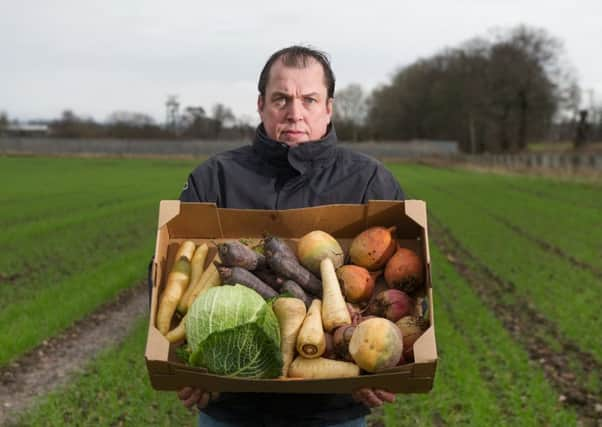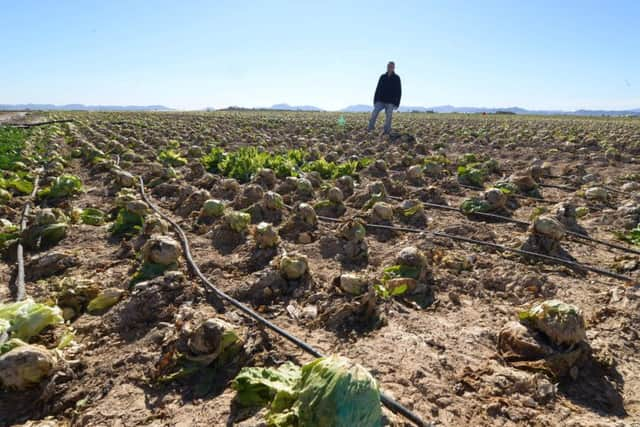Insight: Vegetable shortage a boon for farmers and consumers


In a warehouse packed with fruit and vegetables, James Mackie takes a knife and slices through two beetroots. Inside, one is the colour of sunshine; the other, with its concentric pink circles, looks as if it has been plucked from a Kandinsky painting as opposed to a farm near Turnberry. “That’s a candied beetroot,” Mackie says of the latter. “It can be baked whole, but some restaurants will slice it thinly and turn it into crisps.”
For a long time, the perception of Scottish vegetables was that they were insipid and boring. But at Mackie’s wholesale supplier, Fresh Direct, which sells to the hotel and restaurant trade and has a turnover of £250 million a year, there is lots of eye-catching locally-grown produce on display: lush green cabbages, carrots – purple, black, white and orange – turnips, onions, leeks, parsnips, potatoes and, of course, the beets.
Advertisement
Hide AdAdvertisement
Hide AdOutside, on Mackie’s Barnhill Farm, a stone’s throw from Glasgow Airport, hundreds of dried asparagus ferns stand on ridges of earth across eight acres of a muddy field; come May, the spears will have grown and be ready to harvest. Farming asparagus is laborious, back-breaking work. The weeding and gathering is done by hand, and since it needs to be picked when it reaches a certain length, and can grow up to three inches on a warm day, it needs to be monitored constantly. Added to this, the season is short: a maximum of eight weeks, then it’s all over. Still, Mackie says, the taste is something else: sweet, like pea shoots, it can be eaten raw and cooks quickly.


Mackie’s asparagus, or Albaragus, as he calls it, may be of superior quality, but some of his customers in the restaurant trade – like other consumers – expect to be able to buy it 52 weeks a year, so while his own plot stands waiting for spring, his warehouse is stocked with bunches imported from Mexico.
Normally, Mackie would also be selling lots of courgettes, peppers, iceberg and rocket flown in from southern Spain, but like the big supermarkets, his supplies have been depleted by the harsh winter there. As for aubergines, the increase in cost – from £7 a box to £37 a box – has made them prohibitive. “You have to think about how much you’d lose if a box got damaged or wasted – it’s just too big a risk,” he says.
Over the past few weeks, the shortage of Spanish vegetables has been presented as a culinary catastrophe. Newspapers have called it “the courgette crisis”, “aubergine Armageddon” and the “tip of the iceberg”, and warned of “dark times ahead for vegetable lovers”. Waitrose shoppers have apparently been aghast at the dearth of fennel and red chicory. The situation has been portrayed as particularly dire for guinea pig owners and for those who have embraced the “clean eating” fad: all those spiralisers standing redundant on kitchen shelves; all those zoodle (zucchini noodle) addicts forced to revert to pasta.
Photographs of empty supermarket shelves, and ramped up stories about “rationing” and an emergent black market in which lettuces are being sold on eBay for £50 a dozen, have upped the ante. But confronted by this cornucopia of locally grown fare, you cannot help but ask: “Haven’t we got this a little bit out of perspective?” and “Why can’t we just eat whatever’s in season?”


Not so long ago, that’s how we lived. Our diets changed as the year ebbed and flowed. Root vegetables and Brussels sprouts in winter, cauliflower, spinach and rhubarb in spring, strawberries and salad in summer, damsons and pears in autumn; it gave variety to our larders and a natural rhythm to our lives. In many other countries, this is still the case. Go to Italy around Christmas and the shops and markets will be full of tasty spinach, artichokes, celeriac and broccoli.
Today, the UK imports 50 per cent of its vegetables and 90 per cent of its fruit. The rise of the supermarkets has transformed our eating habits. From the 1980s onwards, the likes of Asda, Tesco, Morrisons and Sainsbury’s created an expectation that all varieties of fruit and vegetables should available all year round. They began to look to the southern hemisphere to supply summer fruit and vegetables during our winter, and vice versa. Nowadays, if you walk into a supermarket on any day of the year, you know which aisle to approach to find the courgettes and the aubergines. And if they’re not there, it constitutes an emergency.
Joanna Blythman, food writer and author of Shopped: The Shocking Power Of British Supermarkets has christened this state of affairs Permanent Global Summertime (PGS).
Advertisement
Hide AdAdvertisement
Hide Ad“The supermarkets encourage this lack of awareness of the country of origin or what’s in season when,” she says. “It suits them because they make a lot of money on fruit and vegetables. They take advantage of the fact people haven’t got a clue what South African grapes should cost. If they put them out at some ridiculously high price, no-one is really any the wiser, other than the wholesaler down the market who is thinking what a nerve they’ve got.”
The consequences of PGS are three-fold: it takes the pleasure out of vegetable buying, it reduces quality, and it makes it difficult for small British growers to survive. “You could go to a British supermarket and it would be really difficult to guess what month it is, because there are always blueberries there are always pears and so on,” says Blythman.
“A lot of this produce has travelled too far. It’s old. It doesn’t taste very good. If you get British asparagus or even European asparagus in May, it’s sweet. It’s delicious. The stuff you get all year round from Peru tastes like the inside of a metal can. So the produce is stale or it’s picked under-ripe because the British supermarkets don’t really care what it tastes like.”
To achieve PGS, the supermarkets appoint “category captains” to ensure the supply of a particular fruit or vegetable throughout the year. Such is their buying power that, when there is a shortage, they will have first claim on limited supplies and so are best-placed to be able to keep providing them for customers.
“I am sure there will be some people whose response to this ‘crisis’ will be : ‘There’s a vegetable shortage, but good old Asda or Tesco are making sure I have enough’,” says Blythman. “It’s another example of how supermarkets are very good at presenting themselves as the solution to a problem they created.”
But the failure of the Spanish crops is also making people re-examine the country’s reliance on foreign markets and feeding into a growing counter-trend away from supermarkets and towards locally produced fruit and vegetables.
The trend can be seen in the growing popularity of organic vegetable boxes and a group of pioneering chefs – such as Fred Berkmiller of Edinburgh’s L’Escargot Bleu and L’Escargot Blanc – who are keen to promote Scottish fare.
“It used to be that high-end restaurants would serve mange tout peas or baby corn flown in from Guatemala or Thailand, but that’s completely dead in the water,” says Blythman. “Now, many of them are making a thing of serving local, seasonal things. Cauliflower, for example, is incredibly fashionable. It has a real cachet. Kale is also super trendy and people have found lots of things to do with it: it can be steamed, it can be served raw, it can be put in a smoothie or crisped up in the oven to make kale crisps.”
Advertisement
Hide AdAdvertisement
Hide AdOf course, we have to accept there are some fruits and vegetables – such as lemons and bananas – which we will always have to import, but we already grow plenty of cauliflower and broccoli, and a growing number of Scottish farmers are experimenting with less traditional vegetables or new varieties of more traditional vegetables.
Mackie and neighbouring farmer Robert Ritchie took the decision to try their hand at growing asparagus in land traditionally used for barley in 2012, investing £9,000 each in the venture. It was a risk because asparagus doesn’t like the rain, and the farmers were learning on the hoof. It takes three years before you can harvest your first crop and a particularly cold winter could prove disastrous. But they have been lucky. Two of the three varieties they have planted have proved successful, and they hope they will cross the two-and-a-half-tonne mark this year.
In addition to the asparagus, Mackie also has wild leeks and recently bought some boar-like Mangalica pigs – the so-called Kobe beef of pork – two of which he hopes to sell to the Ubiquitous Chip.
Perthshire farmer Sandy Pattullo has been growing both asparagus and sea kale (which is in season from Christmas to the end of March) on Eassie farm near Glamis for around 30 years, selling mostly to London restaurants, and Gordon Caldwell, the Turnberry farmer who supplies the beetroots and carrots to Fresh Direct, recently tweeted a picture of his baby kalettes: a cross-breed of kale and Brussels sprouts.
Counterintuitively, for Roots and Fruits – an upmarket shop and café in Glasgow’s West End – the so-called Spanish crisis resulted in an increase in footfall as people read the stories about empty supermarket shelves and assumed they would have to look elsewhere for their vegetables. Kieran Austin, manager of the deli and organics, said the cost of courgettes and aubergines rose so high in early February that they had to stop buying them, but that prices seemed to be stabilising now.
“Our customers are probably a bit more savvy than those buying from supermarkets, but you still get people coming in and asking for soft fruits at Christmas and you have to say: ‘Yes, we can get them, but it will be expensive.’
“Hopefully, this crisis will flag up that we should be eating more seasonally. It’s good for your health. You have your hearty root veg in the winter and your salad in the summer, and so you are well-nourished.”
Yet, if there was a shift towards buying seasonal produce wouldn’t farmers need to upscale to meet demand? “It wouldn’t require intensification of horticulture,” Blythman says. “We just needs lots of small growers. We need lots of little market gardeners close to where people are. And we are already seeing the beginnings of that. We are seeing community gardens and gardens in hospitals.”
Advertisement
Hide AdAdvertisement
Hide AdShe believes the “malign” influence of the supermarkets means horticulture hasn’t developed in the way it should, but that greater biodiversity is possible. Italians are not limited to two kinds of broccoli: they have something like a dozen varieties or subvarieties to choose from. There’s nothing to stop British growers doing that.
As newspapers warn that the vegetable shortage might run into April, most Scottish suppliers seem relatively sanguine about the whole affair. “What Permanent Global Summertime has done is to depress sales of fruit and vegetables in Britain, to turn eating them into a lottery, which is usually disappointing and expensive,” Blythman says.
“But there are lots of young consumers who crave change. I think one day we will look back on [the culture created by supermarkets] and say: ‘That was a very bad time. If we wanted to encourage local growers and healthy eating, we went about it all the wrong way.’”